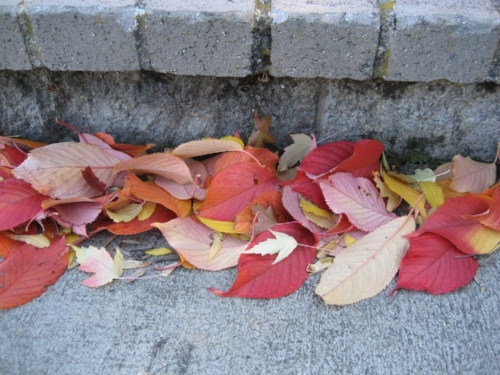Seasonal Rhythms
This week we are fully in autumn. It’s no longer a transitional time from summer, it isn’t a hint of changes to come, it is full on autumn. We’ve had beautiful days, most a mix of wet and sunny, fog in the early mornings, and big gusts of wind. We left the house this morning in long sleeves and sneakers, and watched as the stroller wheels picked up wet leaves from the ground as they turned. We passed through piles of wet gold, drifts of soggy brown, and a beautiful bush that dropped leaves of every shade, bright green, scarlet, yellow, and orange, sometimes all on the same leaf. Our walks are halting because there are so many treasures to collect, the acorns look different on every block, and mama has to take deep breaths to keep up with the very slow pace.
Young children love to interact in a concrete way with the amazing changes going on all around them and the sensory experience of each season. They love picking up and touching and collecting, bringing home the bits of the outdoors to put inside so that their home reflects the season as well. They thrive on anticipation for special days coming up ahead, a chance to plan for and create and participate in family traditions, festivals, and holidays. A seasonal rhythm keeps things interesting, it provides some lively exclamation points against the steady hum of daily rhythms.
What are seasonal rhythms?
- Daily and weekly rhythms that reflect, respond to, and embrace the current season
- The festival calendar for the year
- Family traditions that you build up for each season, holiday, or festival
What can you do to enjoy the seasons with young children?
- Take lots of walks outside.
- Visit the same places frequently throughout the year.
- Take time outside to notice, touch, explore, collect, display.
- Allow your projects, songs, cooking, stories, adventures to reflect the season.
- Create family traditions in each season.
- Mark each season with at least one festival (even something very simple) that you do every year.
First Steps to a Seasonal Rhythm
1. Take a sheet of paper and divide into four sections. For each season, write down your favorite things about the season, favorite qualities, activities, or memories. Also write down any family traditions, festivals, or holidays for each season and anything you would love to do with your children. Refer to this sheet when you plan your rhythm or homeschooling term.
2. Each time the seasons begin to shift take time to consider your daily and weekly rhythms. What is supporting your family and what needs adjusting? How can your rhythm best reflect the upcoming season?
3. Spend time outside with your child every day, just noticing, being there, and allowing your child to develop a relationship with the natural world. Let your child collect special treasures outdoors and bring them home for the nature table or toy basket.
4. Over time you can build up a repertoire of stories, fingerplays, and songs for each season. My favorite resources for seasonal inspiration include this blog of course, The Rhythm of Family book, the Wynstones books, the Seasons of Joy guides, and my own Lavender’s Blue Kindergarten curriculum.
5. Each season build up family traditions that are truly meaningful to you. You can absolutely be a Waldorf-inspired homeschooler without celebrating the traditional Waldorf festivals - the most important thing is to celebrate festivals that are exciting, connecting, nourishing, and meaningful for your own family!
I would love to support you and your family along your homeschooling journey! The Lavender's Blue Rhythm Quick Start Guide is a free guide that will help walk you through the process of crafting your own successful rhythm. Sign up below and I'll send it to you right away!




